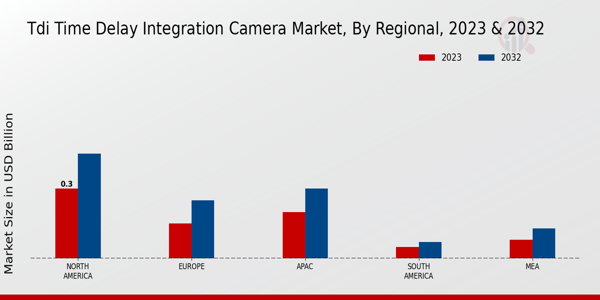Rising Adoption in Medical Imaging
The Global Time Delay Integration (TDI) Camera Market Industry is experiencing a rise in adoption within the medical imaging sector. TDI cameras offer enhanced imaging capabilities that are crucial for various medical applications, including diagnostics and surgical procedures. Their ability to capture high-quality images in low-light conditions makes them particularly valuable in endoscopic and minimally invasive surgeries. As healthcare providers seek to improve patient outcomes through advanced imaging technologies, the demand for TDI cameras is likely to grow. This trend aligns with the overall expansion of the medical imaging market, which is projected to reach new heights in the coming years.
Emerging Markets and Global Expansion
The Global Time Delay Integration (TDI) Camera Market Industry is poised for growth as emerging markets increasingly adopt advanced imaging technologies. Countries in Asia-Pacific and Latin America are witnessing a rise in industrialization and technological investments, leading to greater demand for TDI cameras in various applications. This trend is supported by government initiatives aimed at enhancing technological capabilities and infrastructure. As these regions continue to develop, the market is expected to expand, with projections indicating a market value of 1.37 USD Billion by 2035. This growth presents opportunities for manufacturers and suppliers to tap into new markets and diversify their offerings.
Technological Advancements in Camera Systems
Technological advancements play a pivotal role in shaping the Global Time Delay Integration (TDI) Camera Market Industry. Innovations in sensor technology, image processing algorithms, and integration with artificial intelligence enhance the performance and capabilities of TDI cameras. These advancements allow for improved sensitivity, faster processing speeds, and better image quality, making TDI cameras more appealing to end-users. For example, the integration of machine learning algorithms in image analysis has the potential to revolutionize applications in security and surveillance. As these technologies evolve, they are likely to drive market growth, with a projected CAGR of 5.64% from 2025 to 2035.
Growing Applications in Industrial Automation
The Global Time Delay Integration (TDI) Camera Market Industry is witnessing a notable increase in applications within industrial automation. TDI cameras are increasingly employed in quality control processes, enabling manufacturers to detect defects and ensure product integrity in real-time. This trend is particularly evident in sectors such as automotive and electronics, where precision is paramount. The ability to capture high-speed images with minimal motion blur enhances the efficiency of production lines. As industries continue to embrace automation, the demand for TDI cameras is expected to rise, further solidifying their role in modern manufacturing processes.
Increasing Demand for High-Resolution Imaging
The Global Time Delay Integration (TDI) Camera Market Industry experiences a surge in demand for high-resolution imaging solutions across various sectors, including aerospace, defense, and industrial applications. The need for precise and detailed imaging capabilities is critical in these fields, as they often rely on accurate data for decision-making. For instance, TDI cameras are utilized in satellite imaging and remote sensing, where high-resolution images are essential for environmental monitoring and resource management. This growing demand is expected to contribute to the market's expansion, with projections indicating a market value of 0.75 USD Billion in 2024.
























Leave a Comment